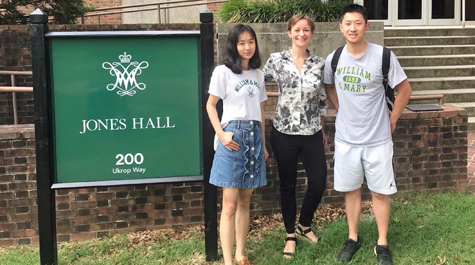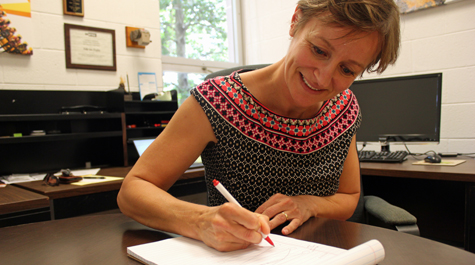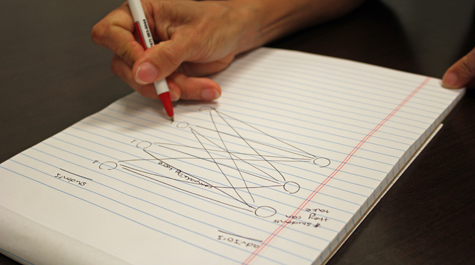Math undergrads design algorithm to pair students with advisors
The new matching system is the result of a collaboration involving two undergraduate students, a mathematics professor and the Office of Academic Advising. Their mission? Build a mathematical model that efficiently pairs freshmen with the faculty member who will work with them from orientation until the student declares a major.
It was quite the undertaking -- and one Academic Advising had struggled with for several years, despite their best efforts, said Academic Advisor Dane Pascoe.
“Every incoming student, and there were 1,600 of them this year, needed a pre-major advisor,” Pascoe said. “Our office has changed a lot over the past five years. I started this job in January and was immediately tasked with finding a more efficient way of approaching the matching process.”
Enter the mathematicians. This year, at the start of the spring semester, Assistant Professor of Mathematics Anke Van Zuylen arranged a meeting with Pascoe. Her newest batch of advisees, assigned in the fall, seemed to have been selected at random.
“All the students assigned to me were interested in things that were way out of my comfort zone,” Van Zuylen said. “They were interested in English, kinesiology, chemistry -- fields that are not my area of expertise. I thought, something must be wrong with how they are doing the matching.”
So Van Zuylen called in a crack team of undergraduate math students to find a solution. Hanmi Zou ’19 and Chengwu Shen ‘19 were enrolled in Van Zuylen’s class, “Introduction to Operations Research,” and approached Van Zuylen about applying their coursework to real-world problems. When Van Zuylen suggested designing an advisor matching system, they jumped at the idea.
“We thought we could build a useful application,” Zou said, “because it was something we had experienced. I came in knowing I wanted to do math, but when I got here I was assigned an economics professor for an advisor. It’s just not helpful to have a bad match like that. The professor is not responsible, but they can’t really help the student the right way.”
“The same thing happened to me,” Shen added. “To a certain extent, it was even worse. I got assigned to an English professor. I had said on my advising questionnaire I was interested in math.”
When Zou and Shen spoke with friends about their project, they quickly discovered their cases were not unique. They encountered many students who had been in similar situations.
“As students, we know personally how useful it is to have an algorithm that correctly matches us with our advisors,” Zou said. “It improves efficiency, but it also enhances the student experience. We know first-hand how important this is.”
After several meetings with Van Zuylen, Zou and Shen landed on an approach. They determined the pairing could be reached through an approach more commonly known in operations research as network optimization. Algorithms for network optimization have been used to tackle real-world issues such as the racial balancing of schools, building evacuation models, warehouse design and large-scale international shipping problems, Van Zuylen said.
“We decided to use an algorithm for the ‘transportation problem.’ This is known as an algorithm for determining the distribution of goods, but we can also use it to distribute students to advisors,” she said. “The goal was to distribute students to advisors in a way that maximized the overlap in interests.”
Zou and Shen devised a method for generating compatibility scores between students and advisors, based on responses to a preference survey completed by incoming students and faculty members. The compatibility score reflected up to five shared academic interests between student and professor. It also factored in a series of other concerns, such as whether the student was an athlete, neurodiverse, a first-generation college student or transfer student.
“We wanted to make sure the matching and advising process was not just about major and course selection,” Pascoe said. “The advisors have a really holistic view of what student success looks like.”
A recent Elon University poll found that college graduates are significantly more likely to describe their undergraduate experience as rewarding when they have meaningful relationships with faculty and staff. The poll also found that of the students who built strong bonds with faculty or staff while in college, nearly two-thirds began those relationships during their first year.
“The model is built to prioritize relationships,” Zou said. “The algorithm takes into consideration all the students at once, so it has a global perspective. It chooses what is best for the whole, not just what is best for one single student.”
The algorithm was deployed and made its first matches this semester. So far, Zou says her analysis indicates the pairs have been successful, but it’s still early. Her preliminary calculations indicate only two students were matched with an advisor that did not have a shared academic interest.
“It’s a project that has an impact on everyone on campus,” Van Zuylen said. “It’s a great showcase for what operations research can do.”
She also stressed that the algorithm was designed to be adaptable, so if the survey needs to account for additional data inputs, they can be added without disrupting the algorithm. The Office of Information Technology has run the algorithm’s code and will continue to do so for years to come, Pascoe said.
“The students developed a product that works and will be in use for a long time,” he said.


















